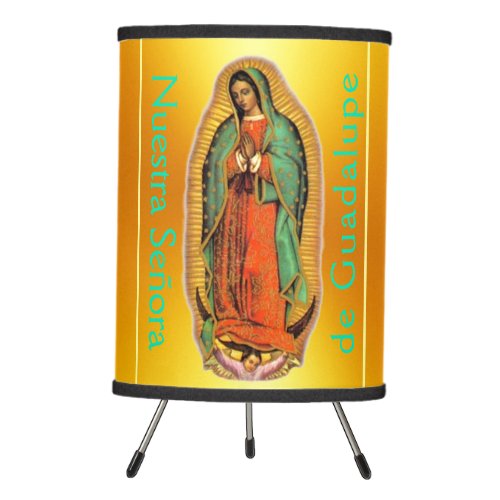Nuestra Señora de Guadalupe Tripod Lamp



Nuestra Señora de Guadalupe. Nuestra Señora de Guadalupe ... Our Lady of Guadalupe (Spanish: Nuestra Señora de Guadalupe), also known as the Virgin of Guadalupe (Spanish: Virgen de Guadalupe), is a Catholic title of the Blessed Virgin Mary associated with a series of five Marian apparitions in December 1531, and a venerated image on a cloak enshrined within the Basilica of Our Lady of Guadalupe in Mexico City. The basilica is the most-visited Catholic shrine in the world, and the world's third most-visited sacred site.[1][2] Pope Leo XIII granted the image a decree of a canonical coronation on 8 February 1887 and was ceremoniously crowned on 12 October 1895. Catholic accounts provide that the Virgin Mary appeared four times to Juan Diego and once more to his uncle, Juan Bernardino. The first apparition occurred on the morning of Saturday, December 9, 1531 (Julian calendar, which is December 19 on the (proleptic) Gregorian calendar in present use), when it is said that an indigenous Mexican peasant named Juan Diego experienced a vision of a young woman at a place called the Hill of Tepeyac, which later became part of Villa de Guadalupe, in a suburb of Mexico City.[citation needed] According to the accounts, the woman, speaking to Juan Diego in his native Nahuatl language (the language of the Aztec Empire), identified herself as the Virgin Mary, "mother of the very true deity".[3] She was said to have asked for a church to be erected at that site in her honor.[citation needed] Based on her words, Juan Diego then sought the Archbishop of Mexico City, Fray Juan de Zumárraga, to tell him what had happened. Not unexpectedly, the Archbishop did not believe Diego. Later the same day, Juan Diego again saw the young woman (the second apparition), and she asked him to continue insisting.[citation needed] The next day, Sunday, December 10 (Julian calendar), Juan Diego spoke to the Archbishop a second time. The latter instructed him to return to Tepeyac Hill and to ask the woman for a truly acceptable, miraculous sign to prove her identity. Later that day, the third apparition occurred when Juan Diego returned to Tepeyac; encountering the same woman, he reported to her the Archbishop's request for a sign, which she consented to provide on the next day (December 11).[4] By Monday, December 11 (Julian calendar), however, Juan Diego's uncle, Juan Bernardino, became ill, which obligated Juan Diego to attend to him. In the very early hours of Tuesday, December 12 (Julian calendar), Juan Bernardino's condition having deteriorated overnight, Juan Diego journeyed to Tlatelolco to get a Catholic priest to hear Juan Bernardino's confession and help minister to him on his deathbed. To avoid being delayed by the Virgin and ashamed at having failed to meet her on Monday as agreed, Juan Diego chose another route around Tepeyac Hill, yet the Virgin intercepted him and asked where he was going (fourth apparition); Juan Diego explained what had happened and the Virgin gently chided him for not having made recourse to her. In the words which have become the most famous phrase of the Guadalupe apparitions and are inscribed above the main entrance to the Basilica of Guadalupe, she asked "¿No estoy yo aquà que soy tu madre?" ("Am I not here, I who am your mother?").[This quote needs a citation] She assured him that Juan Bernardino had now recovered and told him to gather flowers from the summit of Tepeyac Hill, which was normally barren, especially in the cold of December. Juan Diego obeyed her instruction and he found Castilian roses, not native to Mexico, blooming there. The Virgin arranged the flowers in Juan Diego's tilma, or cloak, and when Juan Diego opened his cloak later that day before Archbishop Zumárraga, the flowers fell to the floor, revealing on the fabric the image of the Virgin of Guadalupe.[5] The next day, December 13 (Julian calendar), Juan Diego found his uncle fully recovered as the Virgin had assured him, and Juan Bernardino recounted that he also had seen her, at his bedside (fifth apparition); that she had instructed him to inform the Archbishop of this apparition and of his miraculous cure; and that she had told him she desired to be known under the title of 'Guadalupe'.[citation needed] The Archbishop kept Juan Diego's mantle, first in his private chapel and then in the church on public display, where it attracted great attention. On December 26, 1531 a procession formed to transfer the miraculous image back to Tepeyac Hill where it was installed in a small, hastily erected chapel.[6] During this procession, the first miracle was allegedly performed when a native was mortally wounded in the neck by an arrow shot by accident during some stylized martial displays performed in honor of the Virgin. In great distress, the natives carried him before the Virgin's image and pleaded for his life. Upon the arrow being withdrawn, the victim fully and immediately recovered.[7] Juan Diego's tilma has become Mexico's most popular religious and cultural symbol, and has received widespread ecclesiastical and popular veneration. In the 19th century it became the rallying cry of the Spaniards born in America, in what they denominated 'New Spain'. They said they considered the apparitions as legitimizing their own indigenous Mexican origin. They infused it with an almost messianic sense of mission and identity, thereby also justifying their armed rebellion against Spain.[8][9] Historically the devotion to Our Lady of Guadalupe did not lack significant Catholic clerical opposition within Mexico and elsewhere, especially in the early years, and in more recent times some Catholic scholars, and even a former abbot of the Basilica, Monsignor Guillermo Schulenburg, have even openly doubted the historical existence of Juan Diego, referring to their devotion as merely symbolic, propagated by a sensational cult that wanted to bolster Catholic devotion among the indigenous. Nonetheless, Juan Diego was canonized in 2002 under the name Saint Juan Diego Cuauhtlatoatzin.


